Good morning all!
Today, a different article on the blog (which will be in two parts given all the questions you had) to respond to a request that has been made to us a few times: talk about our experience in Scotland in several aspects. I do not know yet if it will be a recurring article that we will do on each of the countries that we will cross; it will depend on your reaction to it and the time we will have once the heart of our project is really started, but for this time, why not! Before diving into the heart of the matter, a few caveats! First, we don’t pretend to be travel bloggers! What you will discover in these lines is only our personal opinion based on the experiences that we lived. What we like to do on a trip is to discover the cities we cross on foot, to enjoy the surrounding nature when possible, to learn how people live, the history of the country and in the case of David, to taste local food (it’s a lot more difficult for me, but we’ll come back to it). Although we do visit a typical tourist attraction, that is not what attracts us in the first place. Our most beautiful discoveries are those made around a street. So unless you really know the city or the country we are going through, what we will do in our days is very rarely prepared in advance and is often based on what the locals tell us or on what we let’s discover at random our walks. We travel on a small budget so there are certainly things that we would have done otherwise in another context and that we did not allow ourselves this time for this reason!
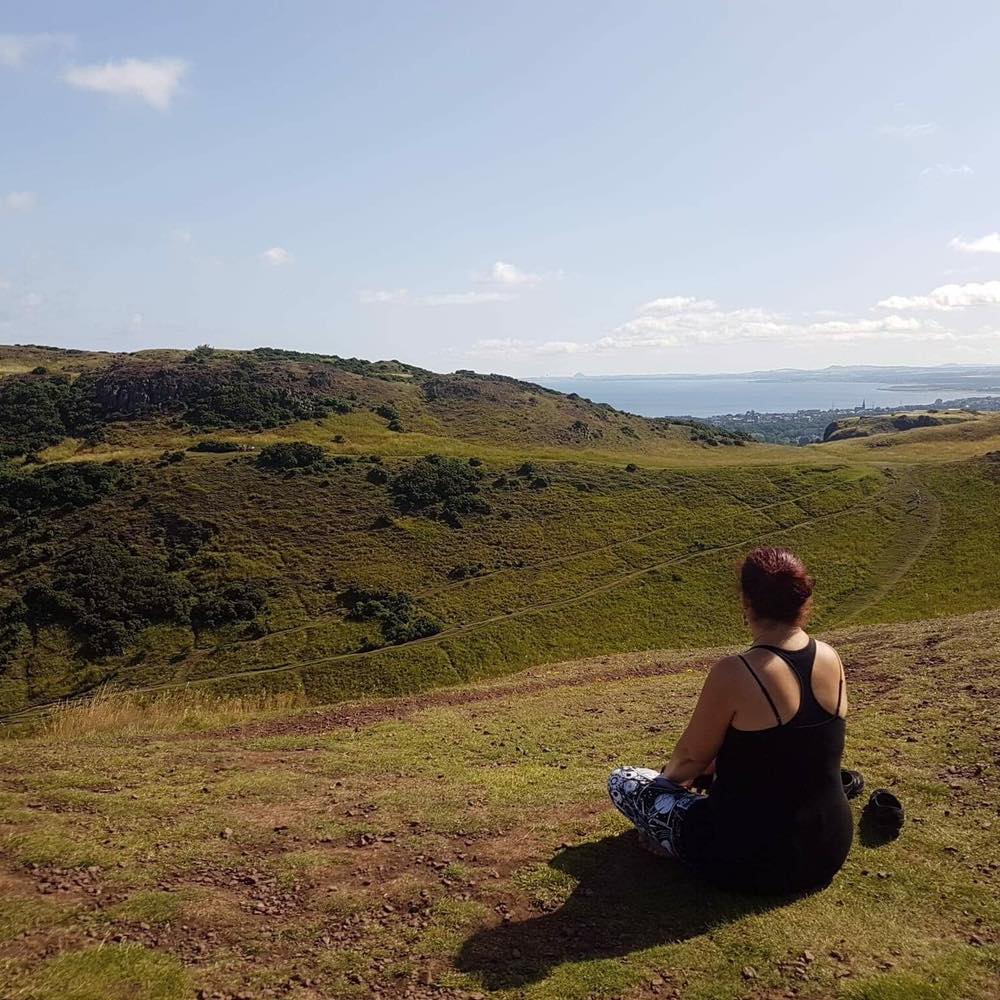
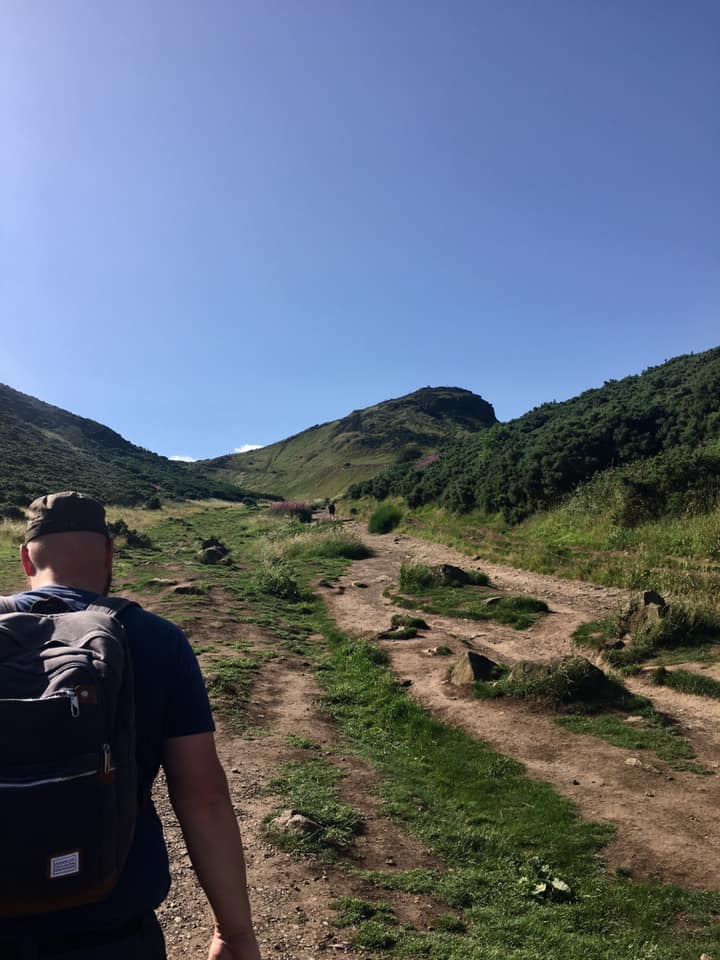
We rent AirBnb for practical purposes (cooking meals) and financial (it would be impossible to travel so long if we went to the hotel and we ate constantly in the restaurant). So we won’t be able to give you info on hotel room costs, but we can still give you an idea for restaurants.
We travel mainly by train, bus and on foot for environmental reasons. Air travel here is very inexpensive, but it is extremely polluting. So once again, we will be able to give you details mainly on these means of transport. This time we can also tell you about car rental and gas prices because we hired a car to go to the Highlands, but this is an exception.
As, to answer all your questions, this article will be very long, I will use subtitles. This will allow you, if you wish, to go only to the passages that interest you.
Well, I think that’s it! Welcome to Scotland according to David and Gen!
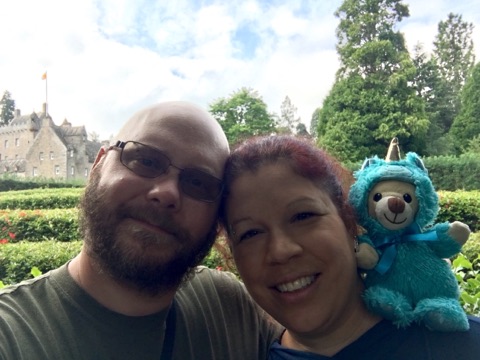
A bit of history
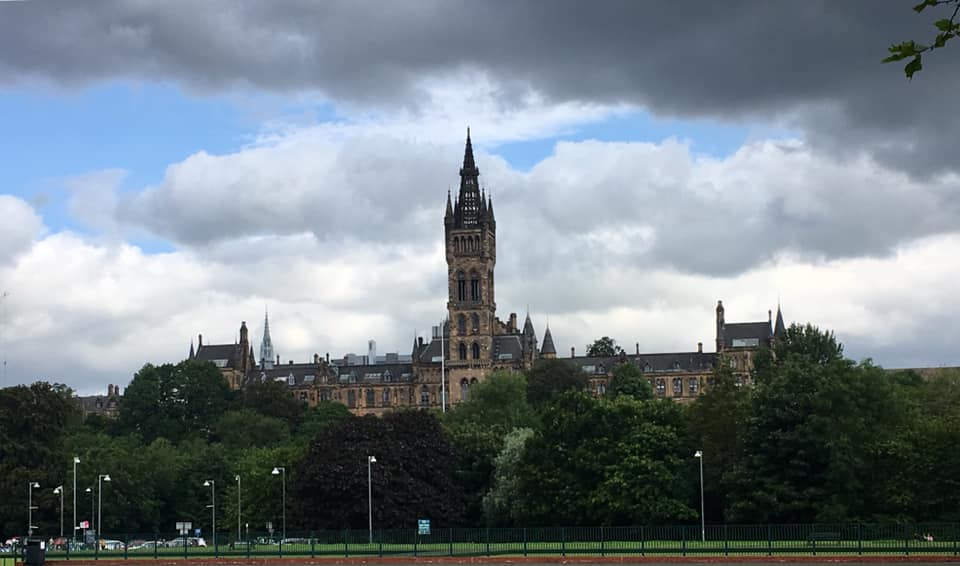
Scotland, this country of mystery, magic, tales and legends, has a very rich history, straddling mythology, imagination and reality. I could talk to you about it for hours, but I will be content with a few aspects that have particularly marked us so as not to make you collapse under the information hi! hi! As you surely know, Scotland is one of the 4 constituent nations of the United Kingdom with England, Wales and Northern Ireland, and one of the six Celtic nations. The Scottish have been known to be resistant and since the dawn of time. Even the Romans, who had nevertheless succeeded in conquering England, never succeeded in Scotland. It was not until May 1st, 1707 that the Act of Union, which then unified Scotland to England, officially created Britain, after hundreds of years of fighting one against the other. But even today, a strong independence movement is very present in Scotland (a referendum rejected sovereignty in 2014, but only by 55.3% of the votes) and resentment towards England is felt in almost every conversation with Scottish. An old alliance against England, signed with France in 1295, was never dissolved. You would have seen the relief of the man who taught me that I was of Scottish descent and not English, it was palpable and very funny!
The human presence in Scotland goes back a long way. Traces proving that man lived in this territory go back to 12,800 years before our era, at the time when, what is today the United Kingdom, an integral part of Doggerland. The British Isles were formed at the end of the last ice age. At that time, the inhabitants were nomadic and lived by hunting and gathering. The first known permanent dwellings, which were built in stone due to the absence of trees, date from 9500 BCE, and the first villages, from 6000 BCE.
The composition of the peoples recognized as Scottish dates back to the Middle Ages when the Celts and the Nordics mainly composed the population. The languages recognized today in Scotland are English, Celtic and Scots due to this fact.
Even though Scotland has been united with England since 1707, it was not until 1746 before a semblance of peace really took hold. Indeed, from the end of the reign of the Stuarts (a Scottish dynasty which reigned over Scotland from 1371 to 1714 and over the rest of the United Kingdom from 1603 to 1714), until this year, 4 great battles had place in an attempt to restore their lineage. All hope disappeared in 1746, following the battle of Culloden, which led to the ban on the traditional Highland way of life, namely the ban on clans, tartans and even bagpipes. A very important fact for what I will tell you next about the tartan and the kilt. We were extremely surprised with what is coming!
The clans
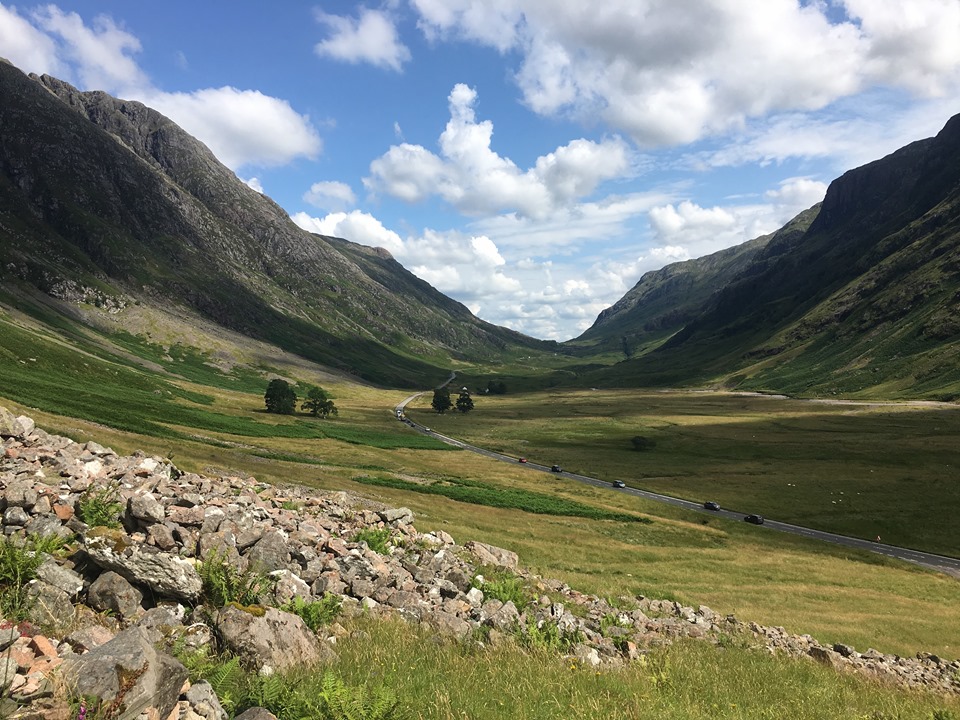
The term clan comes from Scotland even if it does not affect only the Scots. Indeed, this term designates, according to Wikipedia, a set of families associated by a real or fictitious kinship, based on the idea of descent from a common ancestor, which, itself, can be real, imaginary or mythological.
In Scotland, a clan designates a family or a group of individuals with very strong family ties and sharing a common leader. In general, the members of a clan have the same family name, although each clan has “seven”, are family groups with a different name. In many cases, names of Scottish origin are preceded by Mac or Mc which simply means ” son of ”. From 1707, the more the English way of life entered the Highlands, the more the clans disappeared. The British government will put an end to it definitively after the Jacobite rebellions of 1715 and 1745 by making destroy all that is attached to it.
The tartan and the kilts (and do they wear something under the kilt)
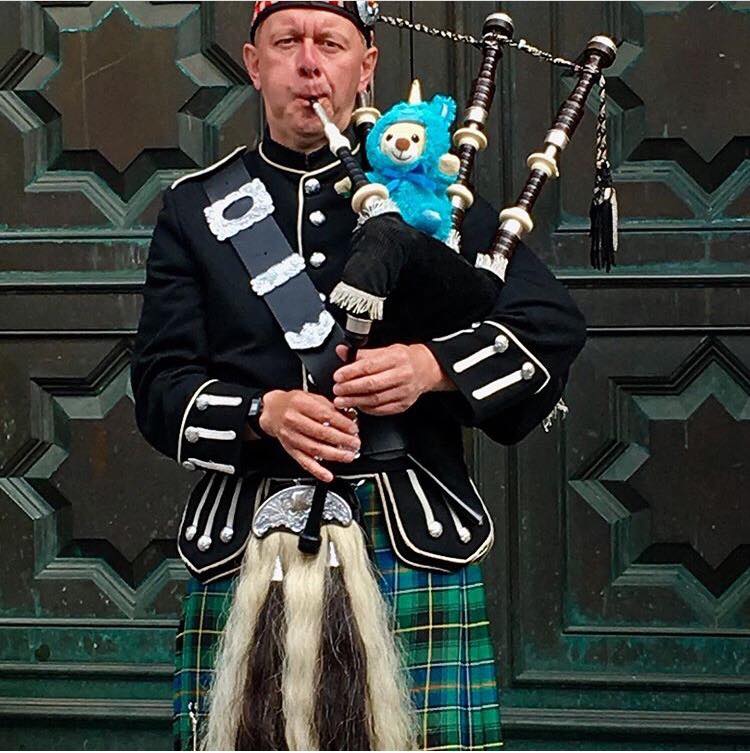
This is where it becomes very surprising, in any case, for us who knew nothing about it. The kilt, like the tartan patterns associated with a family, is very recent. In fact, they date from the early 19th century, a few years after the ban on the Highland lifestyle was lifted (in 1782). Although the tartan has been around for hundreds of years, the differences in the patterns of these were, before that time, much more a matter of taste and financial means of the one who wore these colorful fabrics than anything else, and it could wear several tartans at the same time without any problem. As for those whose means were more limited, they were mostly satisfied with a brown fabric. The kilt, it was first created in 1720 by Thomas Rawlinson to meet the demand of a client. At the time, sewn clothes were very expensive and the employees of this blacksmith could not afford them. They therefore dressed in a plaid held at the waist by a belt. The kilt was therefore thought to be safer than these blankets, while remaining much less expensive than sewn clothing. It was therefore a work clothing for poor people.
So how is it that we are convinced that these two monuments of Scottish culture go back to the dawn of time? Well, this comes from a great need of the Scots to reclaim their culture and create a national identity after the lifting of the ban. Each region has gone back to producing tartans and each has developed its own unique tartan pattern to make it easier and less expensive. When the association of a tartan with a kilt worn by clans, the imaginary idea that such a motif belongs to such clan comes from the visit of King George IV to Edinburgh in 1822. The president of the Celtic Society, Walter Scott, then organizes the welcoming ceremony of the sovereign and invites each clan chief to go there with men wearing the kilt (which has become, since the lifting of the ban, the event dress of the Scots, just like Irish and residents of Wales also) even the king then lends itself to the game. As each region produces its unique tartan pattern, you will understand that each clan then arrives with kilts made from it, thus creating the illusion that they each have their own. They will adopt this tradition at this time, and it is only several years later, while the specialists discover period portraits of famous clan chiefs who wear absolutely nothing in their family’s kilt than the rose pot is discovered!
And to answer the question, “Do they wear something under the kilt?” There are as many answers as there are kilt wearers in fact! Traditionally, the answer is no. nowadays, as it is considered more hygienic, they sell underwear created specially for kilts, and others simply use their underwear everyday. But yes, some people always wear it without anything below! you have to investigate the next time you come across a hi! hi!
Scotland today, its climate and its people
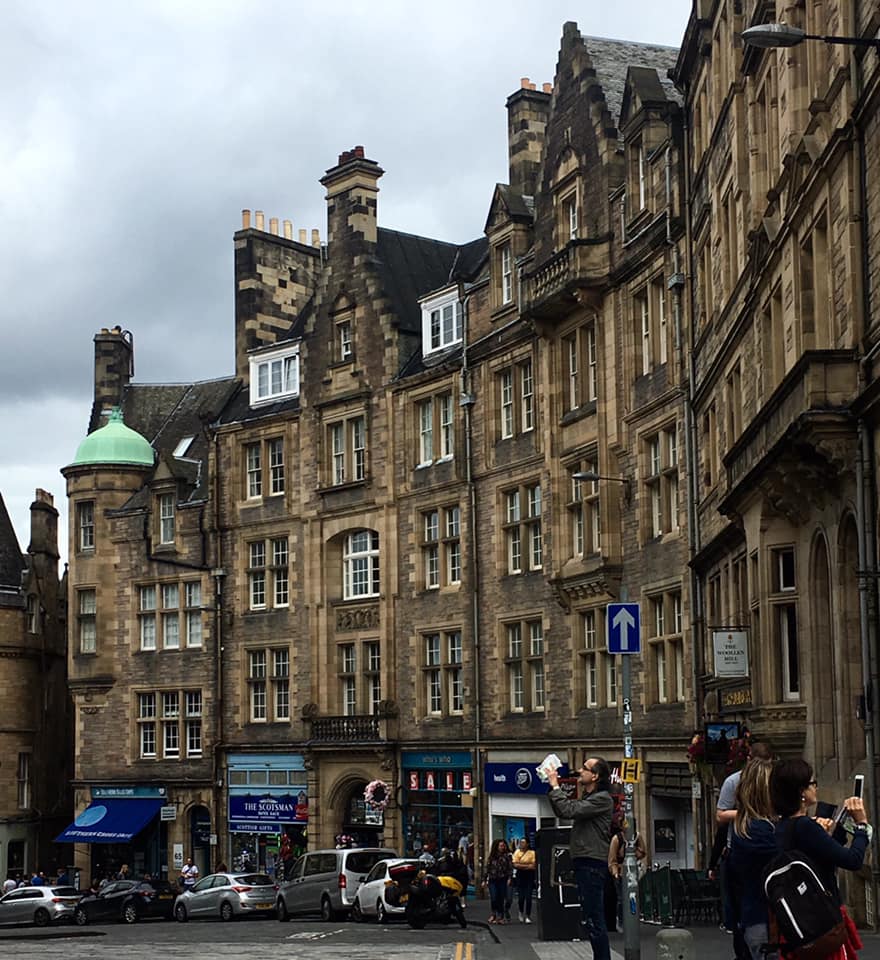
There are approximately 5.5 million people in Scotland. It is still traditionally defined as having two main regions: the Highlands in the northwest (which are today very sparsely populated), and the Lowlands covering the rest of the territory. As you probably know, the capital is Edinburgh, but the most populous city, which is also the industrial heart of the country, is Glasgow. Inverness is considered the capital of the Highlands.
Here, a typical work week for someone working full time is 35 hours and there is a law prohibiting people from working more than 48 hours per week. The average salary is £ 21,480 per year (about $ 34,500 Canadian) and interestingly, as you will see in the table that David prepared for you, the minimum wage increases with the age of the worker, whatever his years of experience.
People here are really welcoming and stop by themselves if you give the impression that you don’t really know where you are. They like to chat and are always ready to give you advice on places not to be missed. The owner of a brewery also took the time to plan for us our route between Inverness and Glasgow to allow us to see as many interesting things as possible on the way back. So don’t hesitate to ask questions. They are proud of their country and it shows!
Question climate, it is about Scotland! So yes, it rains often (but rarely long) and suddenly, so you should always, always have your raincoat with you, even if it is sunny and you only go out for a few minutes. Believe in our experience. I do not recommend against an umbrella since it sells a lot. Seriously, if you think the temperature is unstable in Quebec, you haven’t seen Scotland hi! hi! Level degrees with the thermometer, the temperature in summer rarely rises above 20 degrees. The two weeks we spent in Scotland was the one of the big heatwave in Europe. It was therefore hotter than usual, but it never exceeded 25 degrees. And for them, it was really intense. They were super hot LoL. In winter, the temperature along the coasts remains between -5 and 5 degrees Celsius, but inland, it can easily drop below -30, as in Quebec.
How much does it cost: accommodation and transport!

To give you an idea, we rented a room in Edinburgh, with free access to the whole apartment, but we shared it with other travelers because it contained two rooms. It cost us just over $ 500 for a week and we were in a great location. We were able to do almost everything on foot.
In Glasgow, we rented an apartment a little bit outside the city (the bus stop was close by), and it cost us just under $ 400 for a week too. On the other hand, it was practically impossible to get around without a bus and the cost of public transport is still high (just over 7 pounds per day per person for an unlimited ticket). In addition, be aware that public transportation works weirdly in this city. There are two bus companies and one metro company, and you cannot use your daily ticket with other companies. So you really have to plan your trips accordingly so as not to get caught. If we had to do it again, we would opt for a slightly more expensive apartment but closer to everything.
As for the Highlands, we spent two nights in a type of B&B near Inverness where we had our room, a private bathroom and breakfasts included. The night was $ 80, but it must be said that we booked at the very last minute so hard to tell if it’s in the regular prices. Be careful to read the descriptions carefully if you choose to book an Airbnb in the Highlands, some people, especially in the villages around Loch Ness, only speak Celtic!
In terms of transportation, to get from London to Edinburgh, we used the train. It takes about 4 hours to get from point A to point B, but the landscapes are magnificent and we cross several towns and villages. It cost us less than $ 100 for two. Between Edinburgh and Glasgow, we took the bus for less than $ 12 for two. It is a journey of approximately 50 minutes. For the Highlands, we rented a car at Glasgow Airport (which I suggest is cheaper than renting in the city) and for three days it cost around $ 100. We chose to take an automatic since we already had to think about driving the opposite, and we also subscribed to a separate insurance, but this is optional. It was at the cost of $ 30 per day which is therefore added to this amount and our kilometers were unlimited (if you are going to the Highlands, I strongly advise you to take this option.) Petrol is more expensive (around 2, $ 20 a liter), but the vehicles are much more economical here, which means that, in the end, it is almost the same.
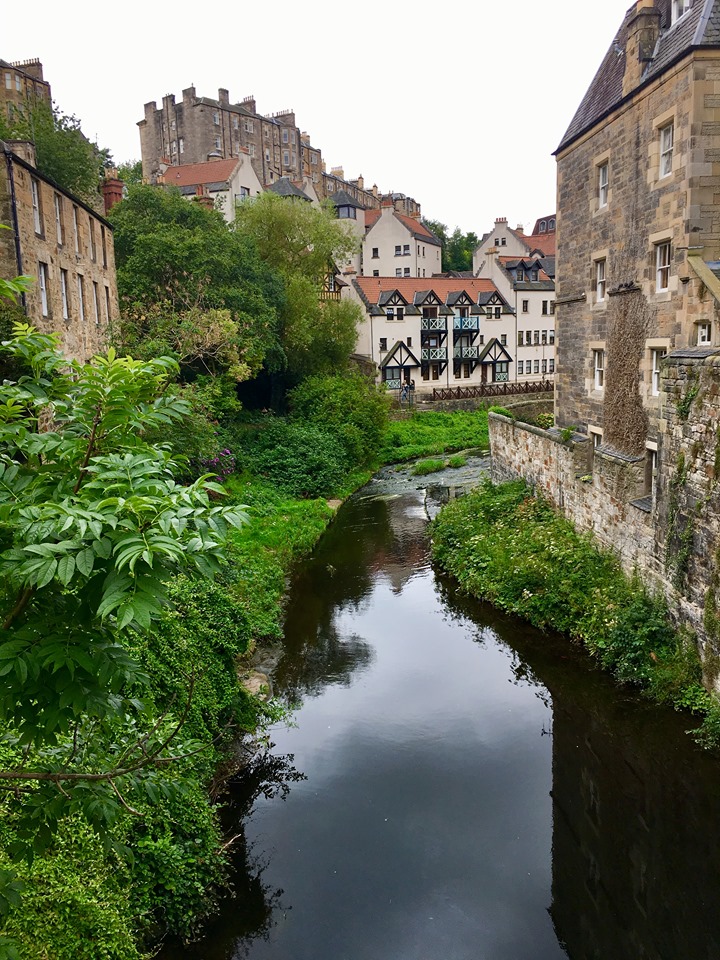
How much does it cost: food
In summary, really cheap! Honestly, we were particularly surprised by this fact. Even with the fact that our currency is much weaker than the British pound (a pound represents about $ 1.61 Canadian at the moment), a restaurant meal does not cost more than ours, even that it often returns cheaper and that, including a beer for David and sparkling water for me, which we rarely take in Quebec usually.
At the grocery store, the price difference is even more striking. On average, you can divide our prices in half. For example, 6 tomatoes will cost around $ 1 Canadian. Here is the comparative table prepared by David on this subject:
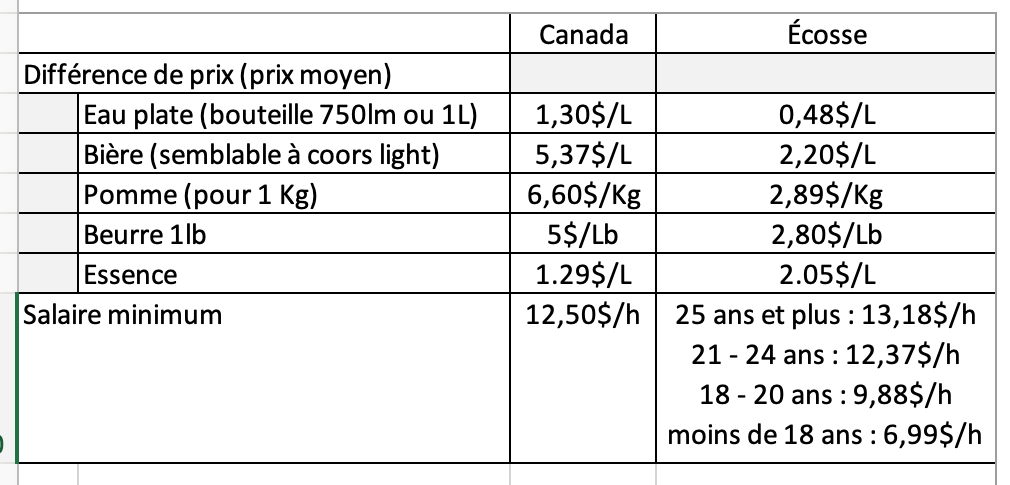 water, beer, apple, butter, gaz, minimum wadge
water, beer, apple, butter, gaz, minimum wadge
For my own products (gluten-free and vegan), you can divide the Canadian price by 3.
Local food
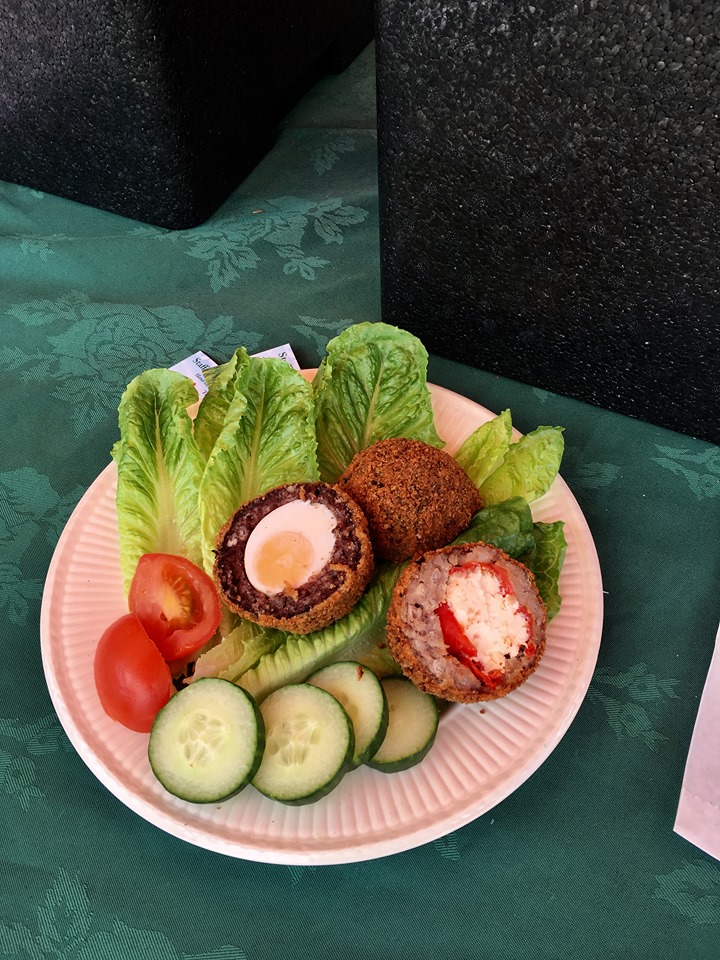
If you come to Scotland, the traditional dishes not to be missed are the haggis (a dish prepared from animal offal (mainly sheep and pork), scotch eggs (a hard-boiled egg coated with sausage and bread crumbs fried in oil) and black pudding. Needless to say, I didn’t taste anything! Like everywhere in Great Britain, there are also fish and chips everywhere and magpies. with local fruits, we find mostly red berries like raspberries, strawberries, blueberries and blackberries. We are in the middle of blackberries right now and there are literally everywhere! Just by taking a walk you can pick by the ton! There also seems to be a lot of blueberries, at least we have seen a lot, but the plants remain full and we have not seen them in grocery stores. It is to be wondered if they consume them … Finally, you cannot come to Scotland and go to c side tape (they call whiskey) and beer. On the subject of beer, it is always a bit confusing to visit schools (especially boarding schools) which date back a few hundred years, and to discover that they often had a micro-brewery to be able to supply the beer necessary for children … the water was not drinkable so you need what you need!
How I manage on food
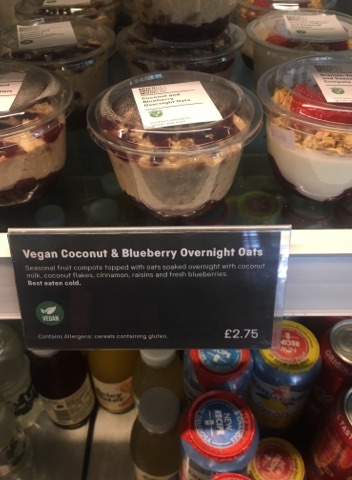
Since we are talking about food, let’s go with this question that has come up a few times in my circle since the beginning of the trip. For those who do not know, I have very many dietary restrictions due to allergies. I cannot eat gluten, animal proteins (so no dairy products, no eggs, no meat of any kind), strawberries, raspberries and cherries and I have an extremely severe allergy to fish and seafood (even the smell creates reactions that sometimes require the use of my epipen). So basically, I have a vegan, gluten-free diet. I grant you, in the majority of countries, including Canada, it’s a real headache, especially when I try to eat at a restaurant, but here in Great Britain, it’s extremely easy , you have no idea. I can eat without problem in 98% of restaurants and if they are unable to offer me something, they apologize 100 times and immediately offer me places where I can eat without problem. It feels so good not to be treated like an extraterrestrial or for people to question the seriousness of my allergies by telling me things like: “Yes, but we hardly put wheat flour in our bread” or “Yes, but it’s not meat, it’s chicken!” Yes, but it really makes me sick !!! But how is it possible that it is so simple here? The British government passed a law a few years ago obliging all establishments serving food to offer at least one vegetarian dish on the menu. A very large part of the restaurants then said to themselves: “As long as we can, make it anti-allergenic as well!” The fact that this type of food is available everywhere made people curious and they started to order these different dishes. As a result, demand has grown and now it’s often up to half the menu of a traditional restaurant or even a pub that is vegetarian, vegan and gluten-free. Even the big chains like McDo or PFK must comply with this law. Obviously, this demand is also reflected in grocery stores. I have never had so many choices in my life for false mages, kinds of bread or even processed products like frozen or fresh meals prepared by grocery stores. I can even buy my bread and my oat or soy drink at any convenience store. The products are also very clearly identified and the sources of allergens must be highlighted in the ingredient lists to be detected at a glance. At this level, Great Britain has a lot to teach us!
As I am about to reach 3500 words, I will leave the rest for part 2. I will then tell you about the differences and similarities, customs, essentials to discover, etc.
Leave me a comment to tell me what you think and if you are interested we repeat the experience on occasion!
See you soon,
Gen